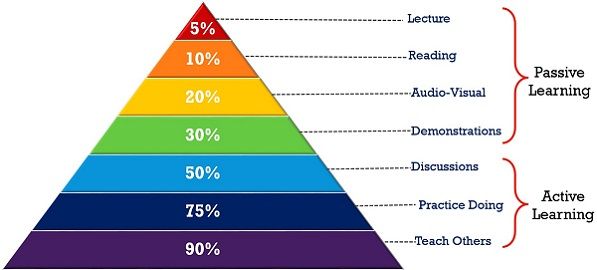 Active Learning is one in which interactive methods are used which improves learning by allowing the learners to participate in the process. On the contrary, passive learning is one in which the students are held accountable for grasping all that is presented to them.
Active Learning is one in which interactive methods are used which improves learning by allowing the learners to participate in the process. On the contrary, passive learning is one in which the students are held accountable for grasping all that is presented to them.
While in passive learning you have to wait for the direction, instruction or information from the instructor to be given to you, in active learning you look for different methods to increase your involvement in the learning process. This means that, in passive learning, information is provided to you and you simply do as per the instructions given to you, be it written or spoken. On the other hand, in active learning, you participate in the learning process wholly.
What is Learning?
Learning is a continuous process, in which essential changes in the learner’s behaviour are brought due to experiences, be it direct or indirect. However, learning does not necessarily mean improvement or development of the individual in the right direction. It is characterised by:
- Universal process.
- Changes in behaviour due to learning is relatively permanent.
- Purposive and goal-directed.
- Encompasses resetting of experiences.
- Product of activity and circumstances.
- Transferable from one situation to another.
- Brings intended change in behaviour
In this written account, we will enlighten you with all those points that differentiate active learning from passive learning.
Content: Active Learning Vs Passive Learning
Comparison Chart
| Basis for Comparison | Active Learning | Passive Learning |
|---|---|---|
| Meaning | Active Learning is that form of learning wherein there is active involvement of the students in the concerned activities and discussions. | Passive learning is when the learners acquire knowledge without making any conscious efforts, in this regard. |
| Student Involvement | Highly Involved | Very less involved |
| Learning | Student-centred | Teacher centred |
| Usage | Used to improve learning. | Used when new material is presented. |
| Knowledge Retention | Very high | Comparatively low |
| Thinking Skills | Higher Order Thinking Skills (HOTS) | Lower Order Thinking Skills (LOTS) |
| Responsibility | Responsibility of learning is taken by the Student. | The teacher takes the responsibility for the student's learning. |
| Role of teacher | Facilitator | Commander |
| Initiates | Divergent thinking | Convergent thinking |
| Source of knowledge | Teacher/Instructor, Books or Online Resources | Hands-on observation, practical application, simulations etc. |
Definition of Active Learning
Active learning can be defined as an approach to learning wherein the students engage themselves in the learning process by developing knowledge and understanding. It demands full-fledged participation on the part of the learner and is not based on classroom teaching, rather it is based on interactive learning sessions.
- Any form of learning in which there is the direct involvement of the learner in the learning process, through a number of individual and group activities.
- It has been proven that – “Learning is more durable and enduring when the learners are cognitively involved in the process of learning“.
This means that when onerous mental efforts are made by the learners, it results in long term retention and understanding.
- The basis of active learning is Constructivism theory of learning, that stresses on the fact that learners construct, i.e. develop their understanding.
In active learning, the student may not get bored easily, because the attention span is longer that keeps the mind fully absorbed. Hence all those strategies that encourage activities involving the learners to perform things on their own and think about what they are doing, comes under active learning.
According to Meyers and Jones, Active Learning is based on two basic assumptions:
- By nature, learning is an active endeavour.
- Different people learn in different ways.
So, active learning is more than just listening to the lecture, i.e. the learners should read, write, act, discuss and take part in solving problems.
Active Learning Methods
Active Learning involves learning by way of:
- Question-answer
- Excursion
- Brainstorming
- Debates
- Strip story
- Dramatization
- Assignments
- Independent study
- Problem-solving
Also Read: Difference Between Debate and Group Discussion
Definition of Passive Learning
Passive Learning means the traditional form of learning wherein teachers are seen as experts and they are expected to transfer knowledge to the learners. Hence, the students have a laid-back attitude, as they learn from what is taught to them by their instructor. Moreover, the student does not get any feedback from the instructor.
- Passive Learning assumes that – “The student’s mind is like empty cups which are to be filled with knowledge”.
- The learners are perceived as a passive recipient of the instructor’s knowledge which means that the learners memorize and imitate knowledge transferred by the teacher.
That is why, no conscious efforts are taken by the learner to gain knowledge, rather a knowledge or ideas are fed to the learner by the teacher.
In passive learning, the student often gets bored or tired easily, which is due to the minimal involvement of the brain during the learning sessions, that limits the thinking ability of the students. Further, it provides only a few opportunities to check the student’s comprehension and understanding.
Passive Learning Methods
Passive Learning involves learning through:
- Lectures
- Tutorials
- Seminar
- Programmed Instructions
- Power-Point Presentation
- Illustration
- Textbook
Also Read: Difference Between Conference and Seminar
Key Differences Between Active Learning and Passive Learning
The difference between active learning and passive learning are discussed hereunder:
- Active Learning is engaging the learners in the learning process, directly and actively. On the other hand, Passive Learning is that form of learning in which students are provided with all the information by the teacher or instructor and they are supposed to integrate it.
- When it comes to the involvement of students, active learning tends to use such methods wherein the students learn the concept by doing and that is why the students need to actively participate in the process. As against, in the case of passive learning, traditional methods of learning are used, in which the involvement of the learner is comparatively less.
- While passive learning is teacher-oriented, active learning is student-oriented, in which the focus is shifted from the teacher to student, as well as from the provision of information by the teacher to active participation by the student.
- Active learning is used to improve learning in students, i.e. it allows the students to learn or educate themselves by constructing their own meanings while performing the activity. In contrast, passive learning is used when new material is presented to the students.
- Obviously, when the students are going to learn the concept by actually performing the activity, they are going to grasp it in a better way, so the knowledge retention rate is high in case of active learning. Oppositely, the rate of knowledge retention is considerably low in the case of passive learning, as the students are dependent on their teachers to provide the information.
- Active Learning helps in developing Higher Order Thinking Skills (HOTS), which may include analysis, synthesis, evaluation, public speaking and collaboration. On the contrary, passive learning often develops, Lower Order Thinking Skills (LOTS) in students, which may include defining, describing, and writing skills.
- In the case of active learning responsibility of learning is taken by the Student. Contrastingly, in passive learning, it is the teacher who takes the responsibility of student’s learning.
- In active learning, the teacher plays the role of a facilitator who creates a favourable environment for the student to gain knowledge, But, in passive learning, teachers are regarded as the primary source of knowledge, so they play the role of an instructor.
- Active learning promotes divergent thinking in students that results in the generation of creative or unique ideas. In contrast, passive learning promotes convergent thinking, i.e. the students will be able to provide the correct answer to a basic question.
- In active learning, the main source of knowledge is hands-on Observation, Practical application, Experiments, etc., whereas in passive learning the main source of knowledge is the Teacher/Instructor, Books or Online Resources.
Development of Skills
Both active learning and passive learning tends to develop specific skills in learners, namely:
| Active Learning | Passive Learning |
|---|---|
| Analyzing | Defining |
| Critical or Creative Thinking | Describing |
| Synthesizing | Listening |
| Evaluation | Writing |
Examples
Some common examples of active and passive learning are presented in tabular form below:
| Active Learning | Passive Learning |
|---|---|
| Taking part in Group Discussion | Hearing lecture during the class |
| Doing Presentation in front of audience | Reading of a textbook |
| Playing a role in Role Play | Seeing pictures, charts, tables and graphs |
| In-depth examination of case study | Watching videos |
| Researching, designing and completing the project assigned. | Watching live demonstrations |
Conclusion
By and large, in passive learning, various pieces of information are regarded as individual units, whereas in active learning you seek the links, to draw connections between different units, to understand the complete picture.







Dongfeng Wang says
I think this view is very nice
Billye J Nipper says
Outstanding articles are relative to teaching and learning. I am downloading it for future reference.